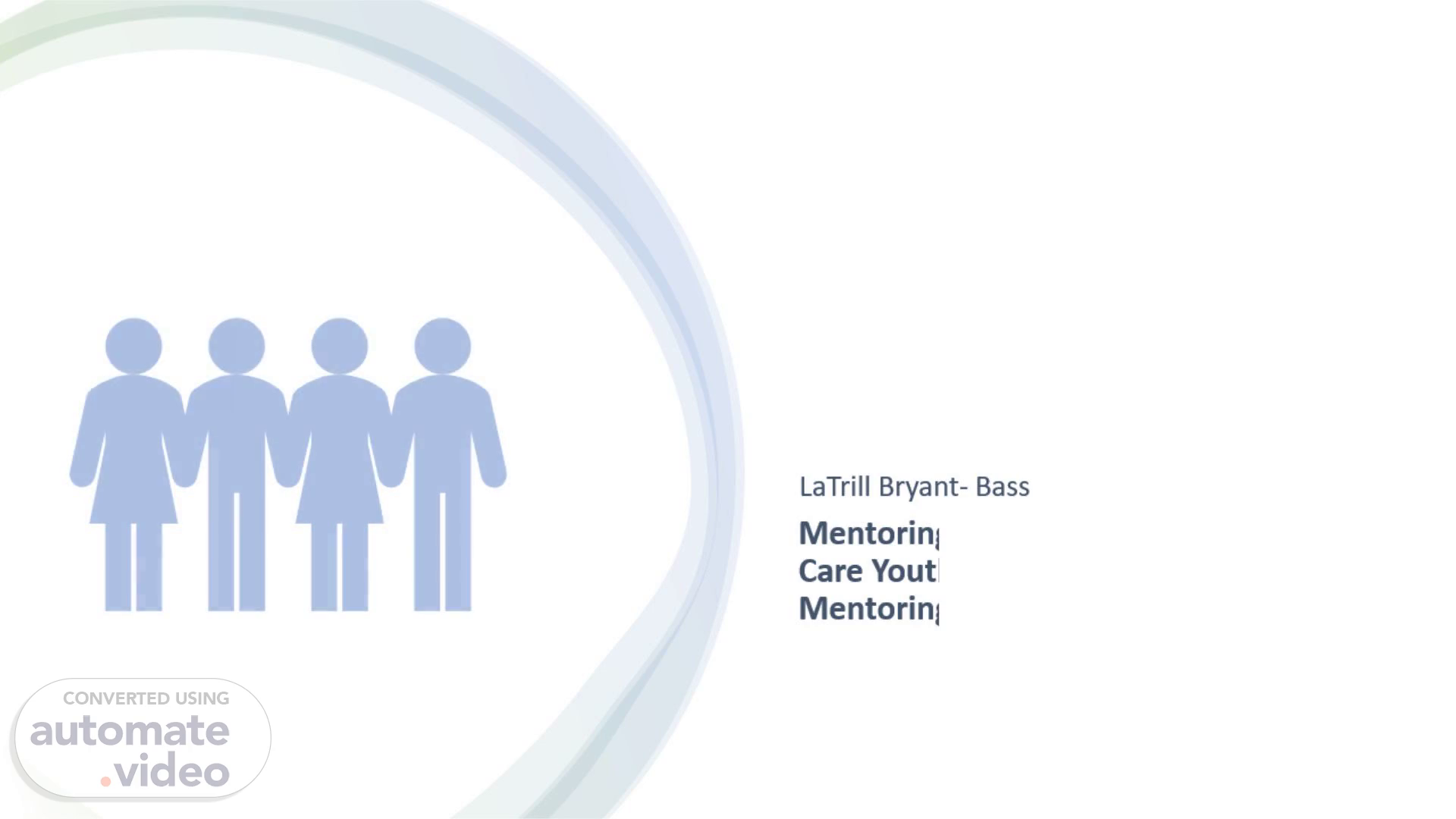
Mentoring the Aging – Out Foster Care Youth: A Business Plan for a New Mentoring Program
Scene 1 (0s)
Mentoring the Aging – Out Foster Care Youth: A Business Plan for a New Mentoring Program.
Scene 2 (10s)
Foster youth are faced with living as young adults without adequate preparation and support.
Scene 3 (45s)
Mentoring the aging – out of foster care youth. The mentoring program focuses on the following aspects:.
Scene 4 (1m 10s)
4. Each youth in the Program will: Have a mentor assigned to meet with them for six hours per month Create their own treatment plans specific to their goals.
Scene 5 (1m 50s)
LITERATURE REVIEW. Major challenges and problems about the successful transition of youth into adulthood include homelessness, employment/education outcomes, criminal behavior/substance abuse, chronic physical health conditions, and emotional/mental health issues..
Scene 6 (3m 1s)
LITERATURE REVIEW. Major challenges and problems about the successful transition of youth into adulthood include homelessness, employment/education outcomes, criminal behavior/substance abuse, chronic physical health conditions, and emotional/mental health issues..
Scene 7 (3m 55s)
Reduced Homelessness Increased rates for high school and college graduation Improved mental and emotional well-being Provide positive outlook for youth as they transition to be independent Reduce the burden on social services by instilling youth with confidence, resilience, and a strong sense of purpose Expected Program Outcomes:.
Scene 8 (4m 19s)
Methodology 1. Holds 20 years of experience serving adolescent girls aged 15-19 in the foster care system as a Residential Group Home Director. Achieved the following qualifications and certifications that exemplify the capability to work with foster care youth: Master in Social Work with a Concentration in Child Welfare Certified Residential Child Care Program Administrator (CRCCPA) Child and Adolescent Needs and Strengths Certification (CANS) Served over 300 youth in foster care Served youth in-patient substance abuse programs.
Scene 9 (4m 41s)
Methodology 2. Program Development and Policies Mentor-Youth Pairing and Goal Setting Step Mentor Recruitment, Orientation, and Training Establishing Collaborative Partnerships Participant Enrollment and Intake Process Program Implementation, Mentor-Mentee Session Flows Curriculum and Material Selection.
Scene 10 (4m 56s)
Situation Priorities ca•e, guitare. and empowerert to care p.jthh preparation heir A%ess te needsd fosv care Nuture a suprt birder b'trn that equps from Favnga wth S'.xtesgul ystinauei± sklts ard resiience "tli± Me essential b their tideperdence and Outputs Number of Mentor-Mentee Pairs: The aim is to match pars wø•in 1st year with an amual % increase. Completion Of Mentor Training: Cc«okte mentor rd certificatül dunrq eaty rnonthS Of Frequency of Meetings: Ensue a ccnststent bi-weekty frequency of menb-mentee meets every month Resource Usage: Track INzatim d al "cqrn resources. Outcomes Improved Educational Attainment: Impro.•eTMt in gra±s. hctease in sch0d graujon rates. increase in college enrolment Increased Employment Opportunities: Monitty reÜess seare empoyment Enhanced Financial Literacy: Improve financial Et•ræy pre• ard post-propm Stable Housing: Reo:$on homdessness ard ncreased stab"ty among participants, Enhanced Mental and Emotional Well•being: Reductd', of eulerqes and improvammt i' overal webbeirq rephr mental heatl assessments Inputs Financial resources: Grants, donators, efforts Human Resources: Dedicated program staff Program Director. Menü Ccordrators. Admin S.ort Training and Development: Trüling Pronm Program Materials: Eüatord Resmrces as vine courses. md rrmtorirq tods Activities Recruitment & Matching: CoröJtt outreæh. nteroea and assess candidates, md math mertot•rentee pars Mentor Training: Provide corrveheneve taring progam folowed by a certificaton Program Implementation: FEItate menü.mentee rraetngs. provide access resources, and organize monfily sodal ard rec•eabond activitÉS Monitoring and Support: Oerseeirg ot menw-mentee reasonships by assgning a Mentor Coordinator Impact Positive Transition to Adulthood: Measure successful transitions into adult100d through achieving in employrnent. ard tusing. Reduced Social Costs: Lower incarceration rates. decrease reliance on emergerty shelters, ard reduce nvotvement with mminal psice system. Stronger Communities: Evaluate program participants' community involvement engagement in volunteering and extracurriculæ activities..
Scene 11 (5m 52s)
Personal Learnings. Rely on evidence-based research and statistics to develop and create the mentoring program for youth aging out of foster care..
Scene 12 (6m 14s)
Project Strengths and Limitations. 12. Strengths Limitations Emotional Support Lack of Engagement and Retention Life Skill Development Trust Issues due to past experiences Positive Role Models Dropout rates can be high Reduction of Adverse Outcomes Educational and Career Guidance.
Scene 13 (6m 28s)
DEIPAR Plan. 13. Diversity lies at the core of our initiative. Actively seeking mentors and mentees from diverse backgrounds, Equity is woven into our mentorship structures. Recognizing the unique needs and challenges of each mentee. Ensuring Inclusion fosters a genuinely inclusive environment that prioritizes cultural competence and sensitivity, creating a space where everyone feels seen, heard, and valued in meaningful mentorship relationships. Addressing power dynamics around empowering mentees on their journey to independence rather than reinforcing power structures. Anti-racism is a non-negotiable commitment. Encouraging open conversations about race, we provide a platform for understanding and dismantling racial prejudices to contribute to a just, equitable, and inclusive society..
Scene 14 (6m 58s)
Future Work. 14. In considering the future development of the mentoring program for youth aging out of foster care, it is imperative to underscore the significance of enhancing social work practice, policy, and systemic changes. The program's success will inspire social workers to develop more tailored interventions for vulnerable populations. Former program participants may become advocates for systemic changes within the foster care system. They can lobby for improved policies, better funding, and increased resources for youth in care (Collins, 2015). Witnessing the program's positive impact, government agencies may invest more in mentorship initiatives. As the program collects data on its outcomes, it can contribute to evidence-based practices in social work. Research findings can inform best practices for supporting youth in transition..
Scene 15 (7m 32s)
Thank You. 15.